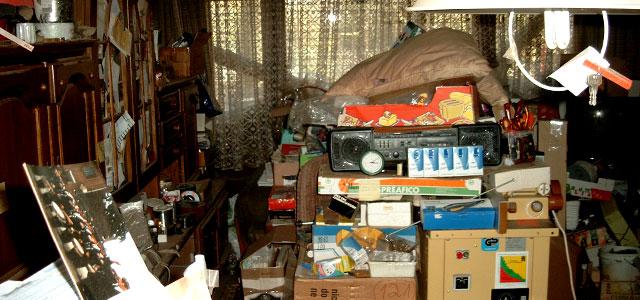
(Photo courtesy of Wikimedia Commons)
Recognizing and Addressing Hoarding as a Significant Senior Health Concern
Monika Eckfield, assistant adjunct professor in the UCSF Department of Physiological Nursing and associate specialist in the UCSF Department of Psychiatry, had heard news reports of pack rats – people living with enormous amounts of accumulated material.
But in the early 2000s, when she became a nurse and a case manager providing services to older people and their families, she was startled to find some of her own clients living in homes so cluttered that it could be difficult to walk in them. One of her clients had multiple sores resulting from falls caused by the clutter. Another kept old medications in a shoebox alongside current ones. Eckfield began to realize that this wasn’t just a clutter problem, but also a health problem.
Her interest in the topic led her to the PhD program at UCSF’s School of Nursing, where mentor Meg Wallhagen encouraged her to study hoarding as a health issue. In 2008, while still a student, Eckfield was invited to join the San Francisco Task Force on Compulsive Hoarding (a joint project of the city’s Department of Aging and Adult Services and the Mental Health Association of San Francisco), which she now co-chairs. In 2009, the task force issued a report that made recommendations for improving and coordinating existing services and implementing new ones, and it has since been used as a resource for cities across the US and worldwide.
Hoarding’s Effects on Health and Well-Being
Hoarding, which studies estimate affects between 2 percent and 5 percent of the population, is characterized by the excessive accumulation of things and difficulty discarding them. The behavior may focus on one type of item – such as books, papers or clothing – or encompass anything and everything. While many of us have more things than we need, for hoarders clutter in the home becomes a barrier to normal activity.
Closets are filled to overflowing. Beds are piled with books or magazines and can’t be slept in. One of Eckfield’s research subjects had a home so filled with papers that she used her stove as a desk and did her cooking in the microwave. Pest infestation, fire risk, difficulty cleaning and deferred maintenance are common problems in the homes of hoarders, and renters with hoarding behavior are often at risk for eviction and homelessness.
Eckfield's PhD thesis, a qualitative study of 22 adults age 65 and older with hoarding issues, found that while hoarding behavior often begins before adulthood, it seems to become more problematic as people age. It's unclear from existing research if the behavior actually worsens or if an individual's ability to cope declines, but hoarding seems to have a great impact on older people.
People with hoarding problems are often undertreated for the medical problems that can accompany aging, says Eckfield. Sometimes, this is because hoarders may need a home health aide but don’t feel comfortable letting anyone into their homes; in other situations, the hoarder may lack the organizational skills to get to a doctor or to follow through with recommended treatment. The crowded physical environment in a home also can contribute to falls, and some older people with hoarding problems cannot use necessary equipment, like walkers or wheelchairs, because there simply isn’t room. Medication errors are also a risk when old medicines are hoarded and confused with current ones.
Interventions for Hoarding
Until recently, efforts to address hoarding have generally focused on massive cleanouts of individual hoarders’ homes. But this doesn’t address the underlying psychological problem, and too often the behavior simply resumes and continues until it reaches another crisis point. “For some people, it’s every six months,” says Eckfield. “It’s very traumatic for them. They need effective intervention.”
The correct intervention depends on the type of hoarding behavior. Although there isn’t yet much research to confirm it, there appear to be two subtypes among people with hoarding behaviors. Some evidence suggests that one group has difficulty with executive functioning: decisionmaking, planning and following through with plans. For these individuals, cognitive behavioral therapy can be beneficial. One area of ongoing research that has shown promise, according to Eckfield, is the use of an intervention based on cognitive rehabilitation of brain-injured patients, aimed at reteaching them executive functioning skills.
For the other subtype – those with impulse control problems and addictionlike behavior – cognitive therapy seems less effective. But as with substance abuse, support groups of peers who can provide a nonjudgmental and safe environment of support and encouragement can help.
Improving organizational skills can also help, and Eckfield points to a multidisciplinary group, the Institute for Challenging Disorganization, that provides education and resources to professionals and individuals dealing with hoarding, including access to professional organizers who offer services targeted at helping people with hoarding issues get better control of their environment.
Ongoing, targeted case management is essential and should be focused on keeping clients independent and safe at home while helping them make progress at their own pace to improve safety and address their medical needs, says Eckfield. She is hoping to secure a grant to work with colleagues at UC San Diego to investigate case management programs that help people with hoarding disorder continue living in the community.
Eckfield also is working on another project with physician Carol Mathews, director of the Obsessive Compulsive Disorders Clinic and co-director of the Anxiety Disorders Clinic at UCSF, and Scott Mackin, a clinical neuropsychologist with the Over 60 Program at UCSF. They are analyzing neurocognitive data from hoarding research participants that may help differentiate the two subtypes of hoarding behavior and lead to more effective interventions that can be targeted to a client’s particular needs.
Reducing Impact at the Community Level
When she became part of the San Francisco Task Force on Hoarding, Eckfield enlisted the aid of Wendy Max – who co-directs the UCSF Institute for Health & Aging and is an adjunct professor of medical economics at UCSF – to put together a picture of the economic costs of hoarding in San Francisco. They determined that hoarding and related events (such as evictions and fires) cost individuals, county agencies and landlords an estimated $6 million per year, the bulk of which was spent on cleanouts, repairs and maintenance that had been deferred on homes of people with hoarding problems.
The 2009 task force report found that spending more money on early intervention could result in long-term savings, better quality of life and improved health outcomes for people with hoarding issues. The report included a list of recommendations for developing new services and building on existing programs that are potentially effective but lack capacity to serve many people. Among them are developing crisis teams to respond to reports of hoarding, increasing access to treatment that can take place in an individual’s home and offering training for therapists, families, landlords, agency staff and others involved in remediating hoarding problems.
One of the key recommendations, says Eckfield, is coordinating services. A hoarding case can involve a multitude of individuals and agencies, all of which look at the problem through a different lens, and the task force is currently evaluating the various tools used by different agencies to assess hoarding. The goal is to identify which one is most appropriate for helping agencies take a “harm reduction” approach by assessing risk in the same way and prioritizing interventions to ensure that the most serious problems are addressed first.
San Francisco has also begun to implement several other recommendations of the task force. Through its Institute on Compulsive Hoarding and Cluttering (ICHC), the Mental Health Association of San Francisco (MHASF) offers training programs for families affected by hoarding, and it has put together support groups, as well as a peer-response team of recovering hoarders who can offer practical support aimed in part at keeping people in their homes. MHASF also sponsors the International Conference on Hoarding and Cluttering, a multidisciplinary event focusing on research, education and self-help training for clinicians, researchers and those impacted by hoarding.
Recognizing a Global Problem
It’s only recently that hoarding has begun to be recognized as a discrete disorder. Despite its prevalence, it hasn’t been listed in the Diagnostic and Statistical Manual of Mental Disorders, but that may change when the new edition is published in 2013. For the first time, criteria have been proposed for diagnosing hoarding disorder, which would make it easier to identify individuals suffering from it.
Eckfield hopes it also will pave the way for more research. Until recently, it’s been “live and let live,” as she puts it, until people get older, and what was once seen as eccentric behavior starts interfering with an individual’s ability to manage the activities of daily living. Further research could shed more light on the etiology of the disorder and lead to more effective intervention.
That’s important, according to Eckfield, because hoarding affects so many people. “It isn’t just an American problem or a disorder of affluence,” she says. “So much of this is common to all of us.”



